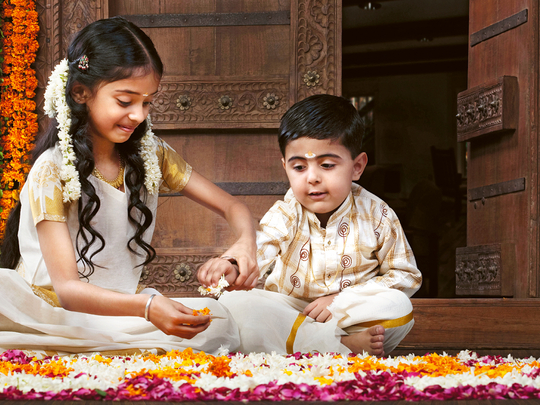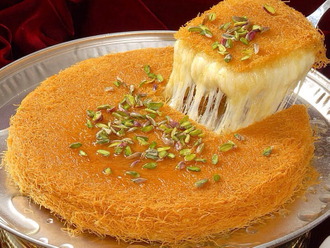
Given the large number of Keralites living in the UAE, it is commonplace for their compatriots to associate Onam with an exotic, extraordinary meal. This festival, perhaps the South Indian state's most famous, is known to other expatriates too, many of who make the general assumption that the day is dedicated to a good harvest and a great feast, much in the manner of Thanksgiving.
Ask anyone who was born or raised in Kerala though, and despite strong protests that Onam is more than a mere meal, they will readily admit that it is morphing into something smaller and slighter than was the wont.
In Kerala, Onam is a ten-day extravaganza with an endless number of traditions, rituals, customs and legends accompanying it, and variations in practices in various parts of the state. But change, like charity, seems to begin at home before it is exported abroad.
For instance, one of the most ritualistic of Onam traditions is pookkalam, the large floral carpets laid out in courtyards and on verandas, explains Dubai resident Kavita Johnny Poopana. Children would be sent far and wide to find specific flowers, and women would spend hours at dawn preparing elaborate designs. Traditionally, the kinds and numbers of flowers increased as the festival progressed, starting with a single white herb, thumba, and ending with ten on the final day. "Today, finding wild flowers is easier said than done, so most people simply buy the flowers they need, or use coconut pulp as another, smarter option."
Although her solution sounds mysterious, it is not. "An extraordinary amount of coconut is used during Onam. After extracting its milk, the fibrous coconut pulp can be dyed, dried, and used instead of flowers to make pookkalam," she explains. "The results are aesthetic, even if not authentic."
Organic, or even electronic, pookkalams may sound like an ode to progress, but most other Onam rituals that have been pruned, pared, adapted or abbreviated stem from a collective desire to save time, effort, and money.
Poopana is new to the UAE, and is ready with a list of time-saving tips and tricks to celebrate Onam with her husband.
"Cooking is never a chore for me, but the prospect of preparing 15 dishes without any assistance is daunting. Thanks to pre-packed ingredients, we can now skip several painstaking preparatory tasks." Her list of 'miracle products' include dried and fried coconut used for erisseri (pumpkin and red-bean curry) and theeyal (small-onion curry), sweet tamarind used for inchipuli (a ginger-tamarind-jaggery side dish), freeze-dried coconut milk used in several festive dishes and ready-to-cook payasam (pudding).
Eating on plastic
"One of the best Onam-related inventions is the plastic banana leaf. Tradition demands that the meal be served on a banana leaf; the plastic version brings hygiene and convenience with the original appeal," Poopana says.
Even if she is prepared for an international Onam, nostalgia for the domestic version tinges Kavita's speech. "Onam is a spectacular season in Kerala; there are performances of Kaikottikkali (folkloric dance) by women, Pulikali (tiger dance) by men, and snake boat races. You can take Malayalis out of Kerala and expect them to celebrate Onam in any place under the sun, but the essence of it is left behind at home," she says.
"We love Onam in the UAE, but every year, we find ourselves sacrificing many rituals to save ourselves time and money," says Dubai resident Bency Sukesh. "The quickest and most convenient shortcut to the traditional Onasadya is of course, eating it at a restaurant," she says. "In Kerala, the festive meal is such an elaborate affair - choosing the best place in the house, identifying positions for the elders, and serving the meal in a specific order. Many of us don't remember these specifications, and most of us don't have the time for it.
A second shortcut is to order complicated dishes, preparing only the simpler ones at home. It is not unusual to attend an Onasadya where half the dishes are purchased."
Joint efforts
The concept of a pound party has also invaded Onam, where three or four families pool their efforts to jointly create dishes. And finally, a staggering percentage of Malayalis, in Kerala and around the world, will sheepishly admit that the very definition of the Onasadya as a pure vegetarian meal is changing. Meat-lovers don't see the appeal of a dozen vegetarian dishes, and a piece of fried fish or a serving of the famed erachi ularthiyathu (spicy beef fry) is surreptitiously making its way on to the banana leaf.
Bency has lived in the GCC for the last 15 years, and each year has seen the introduction of new shortcuts: "I once used to enlist the help of family to buy an expensive 'settu and mundu' from Kerala for every Onam. However, I now wear an ordinary cream-coloured sari that is similar in looks. We meet friends during the festive week, and I see many others wearing the same clothes as the previous year, with different accessories.
"Onam has been modernised, and it is not what it used to be. Why should it not be associated with recycling," she asks?








